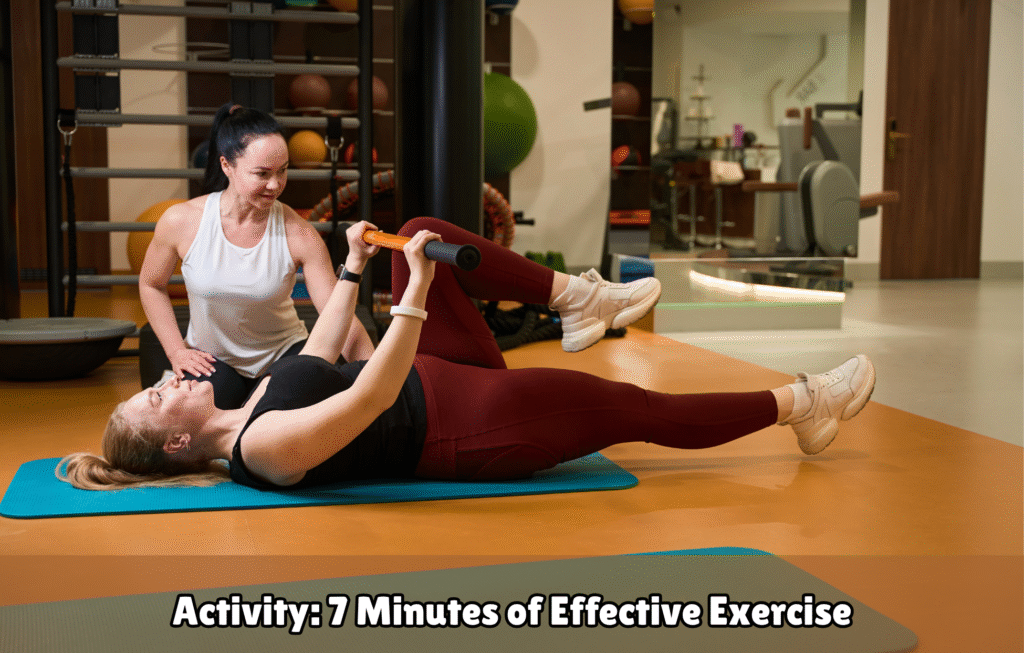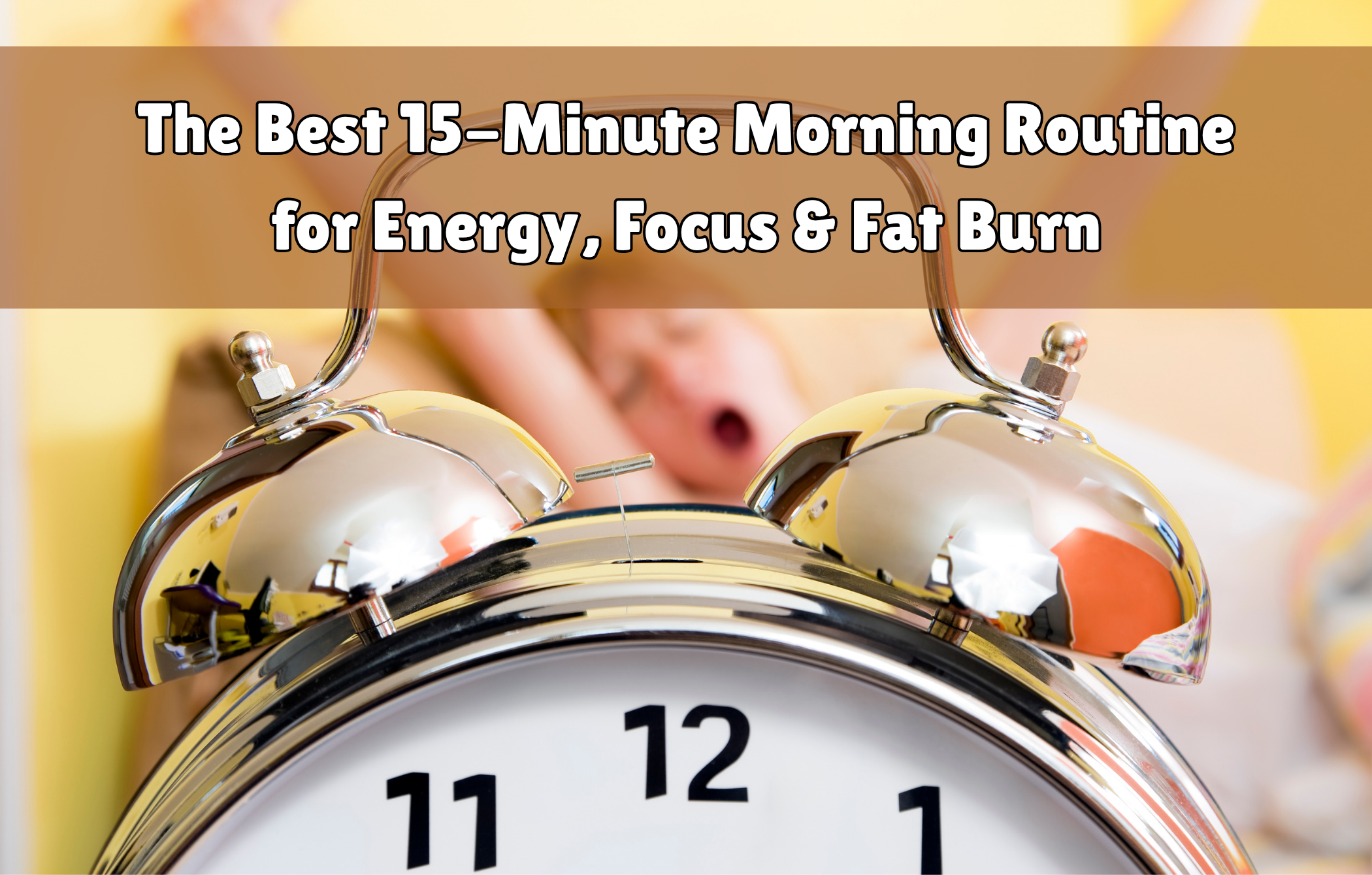Introduction
With the busy lives we live these days, we have a tendency to trust long workouts, complicated routines, or restrictive diets are what it takes to be healthy or energized. But technology verifies that, if finished proper, a 15-minute morning habitual can create the necessary tone for the whole day, both chemically and mentally. A little beginning—finished right—receives each the frame and the thoughts ready: increased strength, sharper recognition, and better burning of fats. Below is a framework based in this, which you may modify on your life-style.
Why does a 15-minute routine work?
1. Circadian Biology and Metabolism
Our body’s inner clock (circadian rhythm) regulates hormone release, electricity use, and fat oxidation at some stage in the day. Recent research suggests that morning workout higher stimulates fat burning than night exercising.
Since our bodies are just beginning the “active phase” when we wake up in the morning, light or moderate activity can stimulate metabolic pathways.
2. “Afterburn” and Metabolic Priming
If you perform a brief but effective exercise session—high-intensity or a full-body circuit—your oxygen consumption still continues even after exercising. This is termed EPOC (Excess Post-Exercise Oxygen Consumption). This gets your metabolism going for a while.
Also, morning exercise “primes” your muscle tissues, blood waft, and hormonal reaction, so that when your body gets the vitamins (protein, carbohydrates) afterward, there is a better chance that your frame will use the nutrients (construct muscle, not store fat).
3. Behavioral Anchoring
15 minutes is a duration that you can easily fit into your routine. Long routines are avoided, but short ones, if maintained regularly in one fixed time slot, can eventually bring huge outcomes. Consistency is the key to outcomes.
15-Minute Morning Routine: Step by Step

Following is an easy yet successful routine—one you can customize to your requirement and fitness level:
| Time | Components | Purpose/Benefits |
|---|---|---|
| 0:00‑0:02 | Wake up + water drinking | Purifying, waking metabolism |
| 0:02‑0:04 | Meditation/Breathing/Mindfulness | Cortisol regulation, mental clarity |
| 0:04‑0:11 | Exercise (HIIT/Whole Body Circuit) | Burning fat, blood flow, metabolic stimulation |
| 0:11‑0:13 | Stretching + sunlight | Supports Recovery, Circadian Reset Signals |
| 0:13-0:15 | Simple Protein-Packed Breakfast | Muscle Preservation, Blood Sugar Regulation |
Following is a description and explanation for each component.
1. Waking Up + Drinking Water (2 minutes)
What to Do:
Drink 300–500 ml (approximately 10–17 ounces) of room-temperature or lukewarm water as soon as you wake up in the morning. You may add a pinch of lemon or salt.
Why it’s Important:
- The body is a bit dehydrated after 6–8 hours of sleep. Refilling water increases metabolism temporarily.
- It flushes out the overnight accumulated waste products and stimulates digestion.
- It sends the message of the completion of the “fasting phase,” and the body might take the cue to go into fat oxidation mode (burn fat).
Never miss this easy step—it puts your day on the right course.
2. Meditation/Breathwork/Mindfulness (2 minutes)
What to do: Select one of the following exercises:
- Box breathing — Breathe in for 4 seconds, hold for 4 seconds, breathe out for 4 seconds, then hold for 4 seconds—repeat for 2 rounds.
- 4-7-8 breathing — Breathe in for 4 seconds, hold for 7 seconds, breathe out for 8 seconds; repeat for 2 rounds.
- Gratitude/Intention Writing — Silently repeat one thing you are thankful for, and choose a positive intention for today.
Why it’s important:
- Body cortisol levels (cortisol awakening response) increase in the morning; This kind of relaxing breathing exercise brings it under control so it does not overreact.
- It is stress-reducing, activates the parasympathetic (relaxing) nervous system, and offers mental purging.
- Accessing peaceful concentration in the morning makes better decisions during the day.
A two-minute relaxation breathing exercise can positively impact stress hormones and mental function.
3. Activity: 7 Minutes of Effective Exercise

What to Do: Select the following alternatives based on your fitness level:
Option A: HIIT / Circuit Style
- 30 seconds work / 15 seconds rest for each movement
- 2–3 rounds
- Sample circuit (each round):
- Jump squats
- Mountain climbers
- Plank-to-push-ups
- Bicycle crunches
Option B: Compound dumbbell / kettlebell flow
- 3 rounds × about 8–10 reps, minimal rest
- Movements: Squat-to-press, kettlebell swings, renegade rows, plank pull-throughs
- This exercise combines both strength and cardio.
Why it works:
- Heart rate goes up and EPOC is stimulated (“afterburn”)
- Large muscle groups are stimulated, causing greater calorie burn and enhanced metabolic signaling.
- Stimulates neural networks, causing enhanced mental alertness and mood.
If 7 minutes is too hard at first, start with 5 minutes and build up.
4. Stretch + Natural Light (2 minutes)
What to do:
- Perform 2–3 gentle stretches: such as hip flexor stretches, spinal twists, shoulder openers
- Look at natural light (sunlight or a bright window) while doing these or immediately afterward
- If possible, get outside and get some morning light for about 2 minutes
Why it’s important:
- Stretching relaxes muscles and aids recovery
- Morning light resets your circadian alerts (vital hormone cycles), enhancing cortisol and melatonin cycles, and improving insulin sensitivity
- Even short exposure to herbal mild can serve as a form of “metabolic reset switch”
5. Easy Protein Breakfast (2 minutes)

What to do:
During these 2 minutes, take 20–30 grams of an easy source of protein, such as:
- Whey or plant protein shake
- Greek yogurt or cottage cheese
- Hard-boiled eggs or egg whites
- A prepared smoothie (for speedy consumption)
Why it’s important:
- Protein has a high thermic effect—it takes more calories to digest
- It keeps blood sugar stable and prevents mid-morning weakness
- It supports repair and protection of muscle
Some gurus recommend having around 30 grams of protein in the first 30 minutes of waking up—this is the “30/30/30” rule. If you’ve worked out on an empty stomach and are feeling a bit light-headed, have protein right after, if it’s not too late.
Put it together: Time summary
- 0:00–0:02 — Have water
- 0:02–0:04 — Breathe/Intention
- 0:04–0:11 — Activity (HIIT or Flow)
- 0:11–0:13 — Stretch + light
- 0:13–0:15 — Protein
This is a sketch — if you need a bit of recovery, or prefer to include a cold splash or contrast breathing — you can adjust ±30 seconds. But the idea is consistency and progressive overload.
Variations, Tips, and Things to Consider
- Begin at your level: If new to this, take the movements to 5 minutes, select low-impact movements (such as bodyweight squats, slow planks), or alternate days with light physical activity.
- Fasted vs. Fed Workout: Working out on an empty stomach can oxidize more fat in the short term, but long-term outcomes are uncertain. If you do feel dizzy, a light snack (such as a banana or some nuts) is okay.
- Don’t Check Screens First: Refrain from using your phone, email, or social media for this 15-minute window. Digital activity can first activate stress.
- Progressively Increase Intensity: Once you become more fit, advance the work time (e.g., 40s of work/10s of rest), add load (weights), or include another exercise.
- First Prioritize Sleep: If you sleep poorly consistently, the gains from this routine will be reduced.
- Consistency > Completeness: Even the days when you are able to do only “hydrate + light movement” are counted. Momentum is the best strength of habits.
How This Routine Increases Energy, Concentration, and Fat Burning
- Energy: Movement raises blood flow, stimulates mitochondria, and increases BDNF (brain-stimulating neurotrophic factor)—all of which keep mind and body alert.
- Concentration: Concentrating on breathing and movement transition eliminates mental fog, tension, and sluggish thinking.
- Fat Burn: When you exercise on an empty stomach or in the morning, EPOC is triggered and morning circadian alignment tells your body to burn stored fat. Protein also spares muscle mass and aids in optimal nutrient partitioning.
Mice research isn’t definitive, but indicates that timing could be a factor. And the human experience confirms it, too: Beginning the day right makes one feel light, refreshed, and energized all day long.
Example Form and Content (for progress)
Variant A (Beginner, roughly 12 minutes):
- Hydrate: 1 minute
- Breathe/Meditation: 1 minute
- Movement: 5 minutes (low-impact)
- Stretch + Light: 2 minutes
- Protein: 2 minutes
Variant B (Moderate, 15 minutes):
- Hydrate: 1 minute
- Breathe/Micro Journaling: 1 minute
- HIIT/Flow: 8 minutes
- Stretch + Light: 2 minutes
- Protein: 3 minutes
And as you become accustomed, you may add a cold splash or contrast breathing between the stretches and movements—this can also enhance arousal and awareness.
Troubleshooting and Common Challenges
- Weakness or Dizziness: Cut the intensity of the movements in half or have a light snack beforehand.
- Time constraint: Do a micro-routine—such as a 5-minute stretch + a compound movement—is better than not doing it at all.
- Mid-morning cravings: Make sure to consume post-workout protein, hydrate, and if needed, a small protein-based snack (nuts, yogurt).
- Sadness/mood slumps: Pay attention—your breath practice or original mental state (opening the phone) might be the cause.
- Stalls in fat loss:Check calorie consumption, sleep, and stress—a morning routine is only part of it.
Conclusion
A 15-minute morning habitual isn’t a magic tablet, but in case you are doing it frequently, deeply, and in concord with your frame’s herbal rhythms, it can be an powerful anchor for the day. The excellent information is—it is clean, less expensive, and no longer difficult to start.
If you do it on a daily (or near-daily) basis for several months, chances are you’ll see:
- More even energy
- Sharper, clearer thinking
- Better mood and decision-making abilities
- Slowly enhanced body composition
Begin slowly, adapt to your circumstances, and build. The initial step is merely being present. As time passes, the 15 minutes will come back to you as an excellent energy, concentration, and health investment.
FAQs
Why is a 15-minute morning routine so successful?
It supports circadian biology, boosts metabolism, enhances mental clarity, and is simple to maintain—making it an extremely effective habit that increases energy, concentration, and fat-burning all day long.
What’s the contribution of circadian rhythm towards morning routines?
Your body’s internal rhythm is geared for activity and fat burning during the morning, so early exercise fits with hormonal and metabolic peaks, which maximize energy utilization and nutrient processing.
Does morning exercise actually burn more fat?
Yes, research indicates morning workouts can trigger greater fat oxidation because of hormonal and metabolic states that support energy utilization from fat stores, particularly in a fasted state.
Hi, I’m veda, a professional health content writer and passionate wellness advocate at HealthTipsIndia.com
. With years of experience in writing evidence-based, reader-friendly articles, I specialize in creating content that empowers people to live healthier, more balanced lives. Whether it’s nutrition, fitness, natural remedies, or preventive healthcare, I translate complex medical concepts into actionable tips tailored for the Indian lifestyle. My goal? To make trustworthy health information accessible to everyone—one article at a time.

